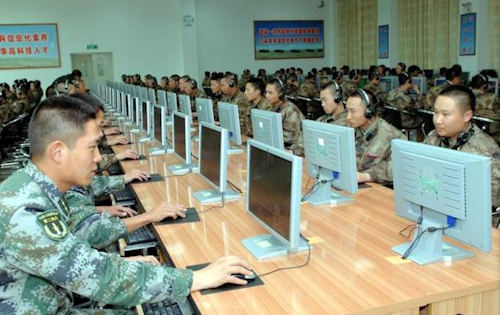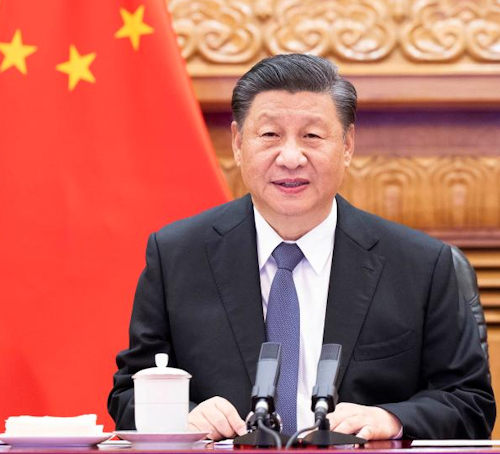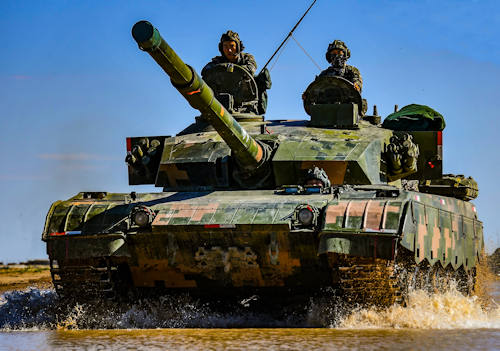If the manifest destiny American of 1840 were not to be considered as a mere theory, it would be politically wise not to underestimate the significance ofTerracotta Army that, after allowing Qin Shi Huang to rise to the imperial throne some 2000 years before America discovered its West, has faithfully accompanied him from the battlefields to the expanses of eternity, nor the recent celebrations of the centenary of the One Party.
Apart from the lyrics, it is a genetic fragment imperial of an ethnic group that has retained a vocation to dominate over a territory slightly less than the USA. The history, rather than erased, should be studied, leaving out the minimis which have never interested any essay Praetor.
Today China has a population1 4,5 times that of America, and a coastline of about 14.500 kilometers, rich in natural harbors in warm waters; a terrestrial power governed with an iron fist, in the perennial search for the strategic depth useful to have the greatest possible space between the fertile territory and the raids of the nomadic populations; a people not forced by necessity to take the sea route.
If it is true that geopolitics analyzes the objectives and resources of a state in a specific space, facilitating relations, it is equally true that China is inspired by a rational balance, it eludes the need to fight for survival, given that it is in the richest areas. that the global strategy is based, an aspect that makes the Pacific, with its emerging markets as well as an obligatory passage of the maritime silk road, and the Indian Ocean even more attractive: the link between resource policy and geopolitics remains the most concrete aspect .
China is geographically advantaged as the Tibet plateau allows Beijing, which controls the continental plate and is the master of attack missile technology, access to the Pacific Ocean to the east and the Indian Ocean to the west, a facility that confers to the People's Republic it qualifies it - only now in its history - of incipient maritime power surrounded by an extension of inhospitable lands. It is no coincidence that the hypothesis of an increase in the intercontinental ballistic arsenal has begun to take shape, which is reflected, as reported by the Washington Post, in the construction of several missile silos in Inner Mongolia and in the province of Gansu, which could be destined for DF-41 nuclear missiles, assuming, of course, that this is not a ruse2, which should be followed by an effective increase in ballistic equipment, according to the same script followed at the time by the Soviets.
Technology remains a geopolitical function; not loved by von Clausewitz for its changeability, its advantage lies in its rapidity of attack, as long as it is not conditioned by external dependencies.
 Cyber domination is fundamental and, in the face of American superiority, China has strengthened the strategy of the indirect approach3. The EPL (People's Liberation Army, ed) prefers forms of conflict that involve the use of AI, gods big data and technologies cloud, including those of command and control, thanks to the synergy between private industry and FA.
Cyber domination is fundamental and, in the face of American superiority, China has strengthened the strategy of the indirect approach3. The EPL (People's Liberation Army, ed) prefers forms of conflict that involve the use of AI, gods big data and technologies cloud, including those of command and control, thanks to the synergy between private industry and FA.
The heart of the Dragon holds the immense river basins of the Yellow River to the north and those of the Yangtse and the Pearl River to the south, an agricultural region that nevertheless offers only a third of the arable land per capita; a ring4 of regions populated by different ethnic groups that surround China colonizing the Han, and which tend to break away from it whenever the heavenly power weakens. Beijing has learned the hard lesson taught by the Mongols who, with their occupation, have branded the need for control over the external regions, the only ones capable of guaranteeing strategic depth.
The Han fortress, when mistress of Tibet, abandoned Xinjiang for convenience by the Turks, Mongolia and Manchuria, it has only 3 points of friction: Vietnam in the south, Eastern Manchuria where Siberia and Korea are lapped, Kazakhstan. Still dominating Tibet allows to keep India at a distance; Xinjiang, Inner Mongolia and Manchuria already in the past created a hinge with the USSR; today, China has no territorial defense problems, but it must cultivate a preventive strategy.
At the moment, the Chinese military economic assertiveness has prompted New Delhi, the promoter of the strategy Act East, to countermeasures that suggest a clash which, given the Pakistani involvement, cannot fail to have a strong impact on the land and sea fronts, and which, in the perspective of Chinese containment, cannot fail to extend from Hollywood to Bollywood5.
However, the most concrete risk now comes from within, given the divergence of interests between the coasts and the hinterland. Han China is not easy to invade, being more closed than any other major geopolitical entity; cyclically it tends to generate chaos and poverty as a result of a development linked to internal demand. Exports therefore remain the backbone of Chinese prosperity, with the consequent need for both a connection with coastal cities and a simultaneous containment of their growth thanks to the opening of trade routes by land: the Silk Road. A fragile way, interested in the withdrawal of Western forces from tomb of the empires, Afghanistan, in the Sino-Pakistani corridor that would accelerate entry into the Indian sphere of influence. The power vacuum created, recalling that US Middle Eastern policy has rarely translated into a benefit, in addition to freeing up resources to support the pivot to Asia, would drain resources by forcing Beijing both to preserve the border with Xinjiang and to seek a point of contact with the Taliban faction.
Beyond foreign exchange reserves, technology and workforce, China owes its prosperity both to the possibility of purchasing its goods, and to an effective logistical capacity capable of making them available, with low-cost management, guaranteed from below. cost of labor, and production increasingly directed towards less affluent markets.
China could divest from the USD, but at what price? Beijing depends on the US much more than the US depends on Beijing, which has to satisfy its customers in order to please its citizens while preserving a crony capitalism.
 Vulnerability
Vulnerability
While the maritime region has grown rich, the hinterland has remained at stake; we therefore have on the one hand the coastal interests linked to those of the investors, and on the other hand the political need to maintain internal stability. If, and when, the global economy experiences yet another critical cycle, exports will collapse, and Beijing will have to balance the needs of the internal area and the coastal area, aware of having to displease them both. The interior of the country, the critical mass, will constitute a concrete threat, while the coastal area, the pivot of the commercial system, will make the distribution of wealth uncertain; it is evident that force, which can be exercised internally, is not exerted externally, in a globalized economic context, unless you want to risk demoting China to Maoist poverty.
If Deng has opened up to foreign investments closed by Mao, Xi has consolidated the pillars of the Army and the Party by ensuring the tranquility of the Eurasian side to turn instead to the threat brought by the US Navy, the only one capable of blocking ports paralyzing China. Realistically, it will take more than a generation for the Dragon to build a trained naval aircraft complex that can compete with the American one. What will affect will not be the numerical entity of the units, but the ability to combine resources, given the existing delay in terms of joint forces, anti-submarine struggle, lack of war experience in the Indo Pacific, where vital routes for development pulsate. Chinese, or as in Djibouti, fundamental for affirming the presence in the Horn of Africa with an eye to the Mediterranean, while the competition with India for the control of Sri Lanka, Maldives, Mauritius and Seychelles is animated.
The current strategy therefore can only aim to make the price of a naval blockade exorbitant thanks to a fragmented missile force, based on anti-ship carriers and space systems, and capable of engaging Americans already in the center of the Pacific. It is evident that the PLAN aspires to ascend to higher levels; the disappearance of terrestrial threats has affected this understanding6 and the new philosophy of use of forces, with a decisive maritime rethinking similar to that theorized by AT Mahan and S. Gorškov, which led to the A2 / Ad7 which defines the set of systems useful for blocking or delaying the arrival of reinforcements (anti-access), or to limit their freedom of maneuver (area-denial).
A more complex prospect for Taiwan, always at the center of political and strategic thought, for which there is still a lack of naval, amphibian and aircraft means necessary for the invasion of a territory that has converted to hedgehog strategy8, and which remains fundamental because in a position that can be used as an air-naval base with which to block maritime transit between the southern and eastern parts of the China Sea, closing access to the northern coast and Shanghai.
The only possible expansion can only be exercised towards Kazakhstan, an energy producer and buffer region between European Russia and China.
Politically, China is a unicum, the expression of a socialism with imperialist characteristics that refer to one heavenly imperial genetics, such as to allow capitalist transformation and internationalization grafted into party ideology; elements substantially similar to the globalization of Clinton and Obama aimed at peaceful relations between states, in a (unlikely) harmonious union between eastern governance and Adam Smith. The CCP, for which Mao appealed to the extinction of classes and parties for the state apparatus, erasing the useless trappings of freedom, has therefore taken on a more incisive role in the economic sphere, an assertiveness indicating a fault point with previous policies, so strong as to hypothesize a new digital currency with legal tender, the e-CNY9, useful both to provide information on financial transactions and to be used to evade US sanctions, but with potential destabilization on the domestic banking system and with domino effects on an international level.
 The CCP's policy towards public and private enterprises will therefore have to find one court balancing the principle of economic and demographic deterioration of the country. And right there demography has become such a problem that, on the basis of moderate ten-year growth, Xi inaugurated the 3 child policy, which disavows that of only child of '79 and then that of two of 2016; however, groped to solve the social problem of the birth rate is related to the ability to inaugurate a strategy that takes into account the consequences that the demographic impact would have on the internal market, putting at risk the achievement of the objectives set by the Party. Beijing, therefore, must both prevent, or at least contain, inequality between classes, privileges and corruption, being obliged to deal with both a question never so uncertain since 2008, both with a fragmented social security system.
The CCP's policy towards public and private enterprises will therefore have to find one court balancing the principle of economic and demographic deterioration of the country. And right there demography has become such a problem that, on the basis of moderate ten-year growth, Xi inaugurated the 3 child policy, which disavows that of only child of '79 and then that of two of 2016; however, groped to solve the social problem of the birth rate is related to the ability to inaugurate a strategy that takes into account the consequences that the demographic impact would have on the internal market, putting at risk the achievement of the objectives set by the Party. Beijing, therefore, must both prevent, or at least contain, inequality between classes, privileges and corruption, being obliged to deal with both a question never so uncertain since 2008, both with a fragmented social security system.
The current socialism it is now distant from Maoist collectivism and, for the legitimacy of power, statism and nationalism remain. China is expanding its global influence in the military, political, economic spheres thanks to the BRI, opposed by the B3W10 proposed by Biden and supported by the G7 during the last meeting in Cornwall, with a soft power which induces to desist from any challenge to the Dragon, however tied to its five-year plans.
The strategic battleground between the US and China is expanding, and the future between the two countries has never been so hazy since the normalization of relations in 1979, also in light of the creation of a regional sphere of influence in which emerging technologies, sources of power and keys to the domination of competition, herald the birth of a digital authoritarianism and where, under Xi, foreign policy seems to confirm more continuity than change; a competition that the US faces to maintain the balance of power.
By increasing influence, Beijing has also increased its ambitions, seeking to remodel the region politically, increasingly resorting to tactical coercive actions just below the threshold of direct conflict: the periphery has become the testing ground for global adventure.
The competition between the US and China is based on economic, military power, cutting-edge technological leadership11: assumptions that already affect geopolitical stability. Two points to remember: communications wireless and the spatial domain. While the 5G controversy still (justifiably) continues, the industry has already begun to turn to 6G, ready for 2030, the most powerful and ideal foundation to support holographic communications and multisensory systems, in a context that points to economic growth. and employment, which must however protect the security aspect.
There is no doubt that leaving 5G in Chinese hands, in addition to opening a flaw in Western communication systems, would give way to implement the know-how of 6G destined exclusively for Beijing, which, prodded by the companies of Elon Musk, invests massively in launchers and spaceships aiming to affirm, even in an unscrupulous way, a predominant cosmic role in the new world order.
 Please allow me to introduce myself, I'm a man of wealth and taste12: or the seduction of the Devil; the smile policy did not prevent restrictions on freedom of expression, economic warfare and the debt trap13; the speech National Communist of Xi for the 100th anniversary of the Communist Party, held in a sadly famous Tien an Men and in line with the recent diplomacy of the wolves warriors14, it was not a formality but rather the seal affixed by the most powerful red prince since Mao's death.
Please allow me to introduce myself, I'm a man of wealth and taste12: or the seduction of the Devil; the smile policy did not prevent restrictions on freedom of expression, economic warfare and the debt trap13; the speech National Communist of Xi for the 100th anniversary of the Communist Party, held in a sadly famous Tien an Men and in line with the recent diplomacy of the wolves warriors14, it was not a formality but rather the seal affixed by the most powerful red prince since Mao's death.
Xi brought Leninist doctrinal references, establishing a line of continuity between the imperial age and the People's Republic, integrating neo-nationalism and Confucianism, on the basis of a long-lived party system exempt from electoral tests, elitist, unable to avoid both the creation of wealth gaps, both the demographic woes.
Meanwhile, China is moving west, weaving a precious string of pearls consolidate partnerships strategic with several coastal states15, follows a thin red line that connects the South China Sea, the Bay of Bengal, the Indian Ocean and the Red Sea, and follows, with its Far Sea Defense Strategy, Mahan's theories, based on the conquest of mercantile and military support points.
Just as the US has contained the Soviet expansion, so too the Chinese maritime tiara aims to isolate India from several points, adding to it the earthly chance of the BRI.
The relationship with Moscow is directly related to the trend of the Russian-American competition, a trend that does not transform the synergy with Beijing into a true alliance16, given the colliding ambitions and the Sino-American commercial prevalence; this aspect reinforces history and geopolitics, given that China, which is encouraging emigration to Siberia towards which an ill-concealed Russian resentment is being directed, has never forgotten how Moscow, between the nineteenth and twentieth centuries, took possession of part of the territory north of Manchuria, and has favored the independence of Mongolia.
The current entente cordial Sino Russian is of a tactical nature, given the impossibility of competing for the Kremlin, pressed by the USA, and threatened in recent centuries from the west and not from the east; at the same time, Beijing is expanding into traditionally Russian areas, namely Central Asia, the Arctic (which returned to the fore with the recent blockade of Suez), Antarctica and Siberia, with the Power of Siberia Gas Pipeline17 together with a greater palatability determined by climate change, from a perspective win win.
Global warming is transforming Russia into the Atlantic - Pacific junction point, and is attracting ever more substantial Chinese investments in Siberia, the subject of a marked expansionism that, on the other hand, Australia is also experiencing, which has formally rejected the claims territorial areas of Beijing of about 80% of the South China Sea, and Bhutan.
So welcome to the new Heartland, Arctic - Siberia - Far East, theater of the Cold War 2.0, which does not preclude the sale of advanced Russian weapon systems to Beijing18, as well as Rosatom nuclear technology, in a growing and dangerous asymmetry.
Conclusions 1. China intends to project itself both beyond the border and into a very near future, where expansion cannot be a peaceful phenomenon; among the various internal problems that differentiate the speed of a country that is and perceives itself as immense, the social one and linked to demographics and wages has a heavy significance.

The Chinese intelligentsia has now concluded that there can be no alternative to expansionist policy, also because the price to pay, in terms of internal conflicts and economic collapse, would be unsustainable.
China seeks support, but its diplomacy, once more shrewd, is increasingly aggressive and commercially pervasive. Beijing cultivates a realistic, pragmatic, organized, wide-ranging vision, a neo-imperial vision that, physiologically, does not admit equal relations.
The ambitions cultivated everywhere, even in Egypt, Ethiopia and Iran, supported by unprecedented rearmament, require containment that takes into account the will to pursue interests considered vital in any case.
The US cannot find alternatives to a situation that has now stalled, not even by following theKissingerian insight, which would point to divide (with Russia) as well rule, perhaps leaving NATO to take control. The question remains whether Yankee have managed to understand it: appeasement of '39 and strategic and bell tower uncertainties should have also taught something. Maybe.
While Beijing and Delhi converge on the Pacific, one wonders who would die for Taiwan, especially if the Dragon should perceive that he no longer has time available to pursue diplomatic action which, in the light of what happened with Covid, has often taken on dramatically contours grotesque.
Conclusions 2. Completely detached from the scenarios mentioned above, our policy deals with an enlarged Mediterranean without grasping its intrinsic geopolitical sense, and above all without enjoying the instinct of strategic projection; looking at the finger instead of the moon, not understanding the sense of subordination imposed by a hegemon like China, will not provide any conscious understanding, but only the sensation of having entered a distant and dark orbit.
1 Nearly 1 billion and 400 million individuals
2 The USA in the 70s, with the MX missile built 23 silos for each carrier and then moved the missiles between them, with a scheme called the "shell game".
3 Basil Liddell Hart
4 Tibet, Xinjiang homeland of the Muslim Uyghurs, Inner Mongolia, Manchuria, historical name of the region north of Korea
5 Admiral Harry Harris, former Uspacom commander
6 Russia from the North
7 anti-access / area-denial
8 Transformation of the island into a fortress
9 the CCP's XNUMXth Five-Year Plan calls for a steady increase in digital currency research and development, while the PBOC and several provincial governments are planning a wider distribution of the e-CNY.
10 Build Back Better World
11 Artificial intelligence
12 Please allow me to introduce myself, I am a wealthy and classy person - Rolling Stones, Sympathy for the Devil
13 Hong Kong, Australia and Montenegro
14 Diplomacy that supported the conspiracy theory according to which the US military would have brought the covid to Wuhan. In France, anonymous articles were posted on the embassy website stating (falsely) that the French authorities had let the elderly die without assistance. When the Australian government with Washington called for an international investigation into the origin of the pandemic, the Chinese ambassador to Canberra threatened boycotts and sanctions. THE wolves warriorsunlike the imaginary special agents they are inspired by, they have not obtained concrete results; instead of protecting Beijing's image, they have damaged its credibility.
15 Myanmar, Bangladesh, Sri Lanka, Pakistan, Djibouti
16 The dialogue between Moscow and Beijing is based on energy collaboration. Bilateral trade based on the sale of Russian gas, reached the $ 108 billion in 2018, an increase of 24,5% over the previous year.
17 gas pipeline operated by Gazprom in eastern Siberia that transports natural gas from Yakutia to Primorsky Krai and to China. It is part of the eastern gas route from Siberia to China. The proposed western gas route to China is known as Power of Siberia 2 (Altai pipeline)
18 S-400 and SU35
Photo: Ministry of National Defense of the People's Republic of China / web / Xinhua












